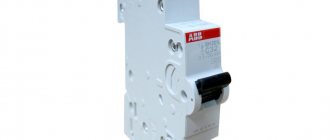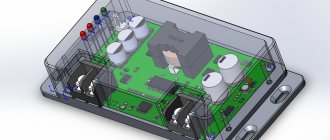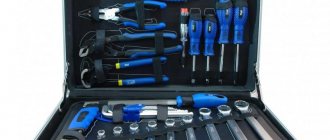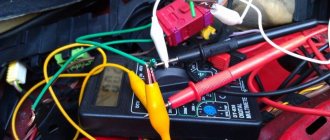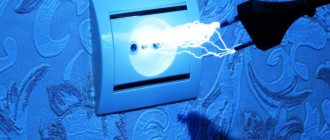One of the main indicators for wiring finders is the detection depth. The maximum operating distance of the detector depends on it. Models intended for domestic use must have a detection depth of at least 5 cm.
An equally important parameter should be considered accuracy. The value indicated in the documentation reflects the permissible error when determining the distance to the cable.
The accuracy indicator for professional devices usually does not exceed 5 mm. Household models have an error of up to 10 millimeters.
The detector can respond to different materials in the walls or ceiling. To accurately locate wiring, you should purchase a device with an accurate detection function.
Wiring and metal detectors - purpose and types.
It’s not necessary to undertake a full-scale renovation of your home only to stumble upon a “unexpected” item in the form of an electrical cable when drilling into a wall - you may need to drill a hole for a single anchor, and a tricky piece of live wiring is already waiting in the wings. If your work is directly related to this, then the need for a hidden wiring detector will be obvious. Fortunately, modern devices are much more accurate and functional than the Soviet method of “plugging an electric razor into the right socket and moving a short-wave receiver along the wall”: they will warn about the reinforcement inside the concrete and find a bricked-up pipe.
So today we will look at which of the detectors offered in hardware stores are really worth the attention and money spent.
Best Budget Wiring Detectors
Bosch Truvo
This device for household use is extremely simple: its entire indication is a “traffic light” indicator lamp, which changes the glow from green to yellow when approaching the metal and to red when it is definitely impossible to drill in this place.
Moreover, a constant red light simply means metal, and a blinking red signal means live wiring. Using Truvo is also as simple as turning it on and that's it. Calibration occurs automatically. The body has marking corners that allow you to quickly mark dangerous places. Please note that the device is designed to search specifically for the wiring of a household AC network 110-240 V with a frequency of 50/60 Hz, and, for example, it will “see” a DC bus as ordinary metal with less accuracy. The depth of detection of hidden wiring here is traditional for this class - 50 mm; Truvo can detect steel reinforcement at a depth of up to 70 mm, and “colored soil” - at 60. For household needs, this is quite enough.
Power source: three AAA batteries. To be honest, a built-in battery would be much more appropriate - the device is still unlikely to work from shift to shift without being plugged in, and nowadays you can recharge from USB everywhere, even to bus stops.
Advantages
- Maximum ease of use
- Not bad sensitivity
- Despite auto calibration, manual calibration is also retained
Flaws
- No accurate indication of burial depth
Review: A high-quality and fairly affordable (for this brand) detector. It catches wiring in plaster perfectly.
ADA instruments Wall Scanner 80
Externally and in terms of characteristics, it is an interesting detector of pipes and wiring, but in practice it is controversial.
Of course, ADA Instruments provided a good “picture” - a shockproof case with a digital display, the ability to search not only for wiring and metal, but also for wood. According to the stated search depth characteristics, the device is identical to the Bosch, and “sees” wood at a depth of up to 20 mm. However, if you pick it up and start using it, the feeling deteriorates somewhat. Moreover, from the moment the battery was installed, the Krona was used here, with its meager capacity. Even a good quality battery will last no more than six hours of operation, and then under ideal conditions. By switching the detector to the wiring search mode, you can find that its accuracy when searching for live wiring is not the best; it happens that in the “metal” mode the wire is localized even more accurately. The advantages of a digital depth indication are clearly negated. Well, when you want to mark the location of the “surprise” you found, you will understand that the manufacturer did not provide any corners or holes for marking.
This is the paradox - although in comparison with ADA the Bosch looks like a simple “display meter”, in practice it turns out to be both more convenient and more accurate. Therefore, the order of places in the ranking of the best wiring detectors is as expected.
Advantages
- "Wood" mode
- Good accuracy when detecting metal
Flaws
- Using Krona as a power source
- Not the best accuracy of the “wiring” mode
Review: Not a bad detector, not professional, of course, but it also helps in the work.
BISON Professional DX-750
This is an exact copy of ADA Instruments, only blue!
In a good way, of course. However, here the characteristics indicate the ability to search for “chernin” in the walls at a depth of up to 100 mm. In addition, it is even cheaper, albeit a little. But, nevertheless, we will set the rating points exactly as you see. Firstly, we are talking primarily about wiring detectors - and Zubr has the same problems with finding wires as the previous participant. At the same time, although its detection of non-ferrous metals is better on paper (80 mm versus 60), in practice the difference is not visible. But, if ADA Instruments is at least a real and well-known Hong Kong company, whose products are sold all over the world, then Zubr is, as usual, an allegedly Russian manufacturer, the real origin of whose goods is more accurate than “somewhere in China ", do not indicate.
Advantages
- Good sensitivity to ferrous metals
Flaws
- Absolutely identical to ADA instruments Wall Scanner 80
The wiring detector works reasonably well for its price. True, he sees fittings better than wires, alas.
Types of wiring detection devices
Actually, devices that detect electrical circuits are not very widely represented. They are called locators (cable detectors) and wiring detectors. They only detect wiring, but there are other devices that can also detect wires hidden under finishing materials.
There are devices that can find metal pipes (and more)
Locators
Locators are connected to the desired network, after which you can search for how the wires are laid. There are models that can “see” even de-energized wires and metal water and sewer pipes. Many of them allow you to search for cables not only in walls, but also in the ground. The search depth is considerable - up to 40 cm in walls, 2.5 meters in the ground. Sometimes more, sometimes less.
Locator is an excellent device for finding hidden wiring
The device creates an electromagnetic field to which the receiver responds. When approaching a close distance, a signal (squeak) is heard. There are several sensitivity levels, changing which from a rough setting to a precise one, in several passes we determine the exact position of the wires (with an error of a few centimeters, but in general the figure depends on the class of the device). The disadvantage of such equipment is its high price. For home use, such expenses are absolutely not justified.
Wiring detector
If you need to locate live wiring, you can use an inexpensive tool commonly called a wiring detector. It responds to the electromagnetic field that wires emit when current passes through them. It is also called a pointer, indicator, detector. The essence is the same - he finds live wiring.
Inexpensive device - hidden wiring detector (detector, finder)
The disadvantage of this device for detecting wiring is clear: if the wire is broken, it will not be possible to find it. Well, other hidden communications are also inaccessible. These devices have one more disadvantage - the search range is too wide, which makes it very difficult to work
When choosing a model, pay attention to this - the narrower the “viewing sector” is, the easier it is to work
Portable metal detector
As you know, all metals conduct current. This is what a metal detector works on. It generates an electromagnetic field, to which metals hidden in the wall or floor react. In this way you can find pipes, racks of a plasterboard partition frame, even masonry mesh in a brick or foam block wall. Since the cables have copper or aluminum conductors, they are also well identified by devices of this type.
One of the Bosch 120 hidden wire metal detectors
But the problem is that with high sensitivity it “sees” everything, even nails and screws. If the sensitivity is set to minimum, there is a possibility that the wiring will not be detected. In general, you need to adapt to working with. And another negative point is that due to the abundance of metal, it is very difficult to work with it in reinforced concrete walls. You can distinguish wiring from fittings only if you have an idea of how the route runs.
Universal (multifunctional) devices
There is a device for detecting hidden wiring, which can also find non-energized metal, wood, and plastic. His work is based on the fact that different materials have different densities. The device emits waves of a certain length and, by the nature of the reflected signal, determines what kind of material is in the wall. Information about what exactly was found is displayed on a digital or LCD display, so it’s not very difficult to navigate what exactly was found. But, as with any equipment, you need to get used to these devices.
Universal devices - they find everything well, but the cost is high
The disadvantage of this type of equipment is that it is difficult to work with them on walls made of materials with voids: hollow bricks, cinder blocks, etc. It reacts to every irregularity, so it will be very difficult to understand the picture.
A universal detector is more complex equipment and its cost is significantly higher than the devices described above. Household class models are rare in this group; almost all models are semi-professional and professional
Please note that almost all of them require configuration before starting work. It consists in the fact that the device must be applied to a wall for some time, in which there are obviously no inhomogeneities
This is so that he can take a “sample” of the density of the wall in which he is to look for inhomogeneities. Without this setting, he completely lies, you can’t be sure of anything.
The Best Mid-Range Wiring Detectors
Bosch GMS 120 Professional
A good universal detector that is capable of “seeing” live wiring at a depth of up to 50 mm, steel - up to 120. When searching for de-energized wiring, you will have to rely on the “color” mode with a maximum detection depth of 80 mm.
Tree search is possible at a depth of up to 38 mm. The device has a double indication - a liquid crystal display and a color-changing “eye” rim, through which you can immediately mark the location found with a pencil or thin marker. True, it is worth noting a feature of the device that is not always paid attention to (it is customary to read the instructions when something breaks, as you know): the duration of auto-calibration of the device after switching on is at least 8 seconds, and all this time it must be guaranteed is distant from the metal, otherwise it will begin to show, if not “the weather on Mars,” then “the average temperature in the hospital” - for sure. Also, do not forget about manual calibration, following the conditions specified in the same instructions.
An interesting feature of the GMS 120 is a separate “drywall” mode, in which, by the way, the device can also detect plastic pipes with water. The rest of the set of modes is traditional - “metal”, “non-metal”, “live wire”.
Alas, despite belonging to the “blue” professional series, the device cannot be classified as truly professional - this is not the case when Bosch turned out everything as planned. The device is still not “long-range” enough, and is simply capricious in terms of operating conditions.
Advantages
- Good sensitivity to metal
- Ease of marking
Flaws
- No depth indication
- Sensitive to operating conditions and requires regular calibration to maintain accuracy
I expected more from Bosch... Although, of course, this is not a locator, but a metal detector after all.
ADA instruments Wall Scanner 120 PROF
According to the stated characteristics, this wiring detector is a direct competitor to Bosch, and at the ADA price it is even more interesting.
True, for some reason the manufacturer plugs the hole inside the ring indicator with a plug, which is not always pulled out, even if you try hard - but how do you order to mark the found point? According to the narrow “marking lines” on the front panel, as indicated by the instructions? It’s frankly inconvenient, and it’s unclear what prevented the manufacturer from making the same hole as Bosch’s. In general, the device is interesting if you know how to use it (the nuances of detectors of this type are discussed below). True, using the same “Krona”, it is not very economical; you should always have a spare battery on hand.
Advantages
- Good metal detecting mode
- Quite comfortable case
Flaws
- High sensitivity to interference in wiring search mode
- Pointless plug in the sensor hole
It works, in principle, at the same level as the Bosch 120, plus or minus, but cheaper.
Bosch UniversalDetect
A curious case: in terms of price, a device from the “green” amateur series costs the same as a “blue” detector.
At the same time, its characteristics are stated to be worse - searching for wiring at a depth of up to 50 mm, metal - up to 100 mm. We pay here mainly for a color screen that displays no less than a “live” animated instruction manual: a device for those who fundamentally do not read instructions on paper. Otherwise, the detector is just like a detector, nothing unusual. But it fits comfortably in the hand, with dot markings like ADA, there are no stupid problems (the hole is open), so it is eligible for purchase.
Advantages
- Search for live wiring, metal, wood
- Help at your fingertips
- Powered by AAA batteries, not Krona
Flaws
- Performance characteristics are weak for this price
- Inability to search for stranded wiring without voltage in the “Metal” mode (directly stated in the instructions)
Well, the detector is at least convenient; if you know how to use it, then the risk of missing is normal for this class.
ELITECH D 100
Another case when a wiring detector in terms of characteristics is not very far from good “state-funded” ones, but in price it is already ahead of them.
In principle, it works quite reliably with both wiring and Elitech metal. But its display is terrible - it looks like it was taken from radio designers from Aliexpress like “Arduino color screen hot free delivery”, small and illegible (but color, yes). It is small in size, dim, and its viewing angles are not the best. Honestly, a regular black and white screen would be both more convenient and appropriate here.
Advantages
- Fairly confident search for live wiring
- Good metal detection depth
Flaws
- Low display quality
- Lack of a clear marking device
The screen is illegible, but in principle I liked the detector.
Elitech D 80
Main characteristics:
- Maximum wire detection depth - 50 mm
- Maximum detection depth of ferrous metals - 80 mm
- Maximum detection depth of non-ferrous metals - 60 mm
- Maximum wood detection depth: 20 mm
Functions and capabilities. This detector is designed to search for non-ferrous and ferrous metals, live wires and wooden frame parts of plasterboard sheets. It determines not only the location, but also the depth of an object with an accuracy of 1 cm. The energy source is a Krona battery, which lasts for 5-6 hours of operation. There is an indication of the charge level and automatic shutdown in the absence of operator action. Application conditions from -10 to +50°C allow the device to be used even on buildings under construction.
Ease of use and management. This model weighs 240 g. It has a textured body and rubber linings that contribute to a secure grip. All the most important readings are shown on the display. To simplify the search, color indication is provided. The control panel includes only three buttons: start and select the required mode.
Equipment. The device is sold with a storage case, battery and instruction manual.
Pros of Elitech D 80
- Ease.
- Ease of Management.
- Convenient shape.
- Two operating modes.
- Shows the burial depth.
- Low cost.
- Case.
Cons Elitech D 80
- Needs regular calibration.
- Low measurement accuracy.
The Best Professional Wiring Detectors
Bosch D-tect 150 SV Professional
But this is a serious professional-class “station wagon”, albeit with an appropriate price.
It recognizes metal at a depth of up to 150 mm, live wiring - up to 60. It also “sees” plastic pipes with water. The power source is again batteries (although in Bosch levels, for example, they have already begun to be replaced by standard lithium-ion batteries), but at least not the damned “Krona”, but 4 AA batteries, which can be replaced with batteries of a similar size. The detector’s display is informative, but the Russification kills - it displays all messages in transliteration, like “Dvigat” or “Kabel pod napryaz”. For an expensive device, this looks strange - although, perhaps, razrabotchiki simply re-read Burgess and started talking on Nadsat? But the signal viewing mode (called Promotr signala... no, we’d rather say it in English - Signal View) here is often able to show even two adjacent valves separately, and not as a single object: the accuracy is excellent. Additionally, a useful measurement mode has been introduced for wet concrete separately from dry concrete, which is so lacking in cheaper devices.
Advantages
- High accuracy
- Adjustable for wet and dry concrete
- Moderate sensitivity to interference
Flaws
- Disgusting Russification
- High power consumption
The only device of this class that (out of those that I have tested) can truly be called professional.
Bosch D-tect 150 Professional
Externally and in terms of performance characteristics, the D-tect 150 is no different from the version with the SV prefix, but at the same time it costs less.
The difference is that this model does not have the Signal View mode, that is, it is somewhat rougher, and can recognize nearby foreign inclusions in the wall as single. If you do not require maximum localization accuracy, but just indicate an area where it is better not to drill a wall, then you do not need to overpay several thousand for the option with the SV mode - otherwise the detectors are identical.
Advantages
- Similar to D-tect 150 SV
Flaws
- In addition to the above - a little rougher work
In two years there have been no complaints about accuracy; it works as it should.
Which hidden wiring detector is better to choose?
Not all industrial metal detectors are equally effective at detecting a cable, pipe or reinforcement element inside a building structure. The selection of such equipment should begin with the formulation of the tasks that it will have to solve, after which the required characteristics and additional capabilities are specified.
How to decide on the type of detector
You can remotely determine the presence of metal or other foreign inclusions in a building monolith in various ways. The detectors available on the market for special equipment differ in their operating principle, functionality, energy consumption and many other parameters. Let's move on to a description of the most common types of devices.
Electrostatic detectors
Electrostatic devices are among the simplest and cheapest devices. They respond to the presence of an electric field, which always forms around an energized object. They can be used to search for hidden wiring laid at a depth of 5-7 cm.
The disadvantages of such devices include the inability to locate shielded cables and low-current networks. Their operation is negatively affected by nearby power equipment.
Demonstration of searching with an electrostatic detector.
Electromagnetic detectors
Electromagnetic devices are sensitive to alternating fields that arise in the vicinity of any conductor with current flowing through it. They are quite accurate and cheap, but they cannot detect a cable that is energized, but does not have an electrical consumer connected to it at the end. To use it to search for all the wiring in the room being examined, you need to turn on the lights and use all the sockets.
Electromagnetic detector in operation.
Metal detecting devices
These detectors are more complex in material design and are more expensive. They create their own electromagnetic field, forcing all nearby conductors to “respond” to it. Having caught the response signal, you can easily detect a reinforcing bar, cable or nail driven into the wall.
Metal detector device in operation.
Capacitance detectors
The principle of operation of capacitive sensors resembles electrostatic ones, only they charge metal elements hidden in the wall with their own field. They are cheap, but not as accurate and are subject to random interference.
Ultrasonic detectors
Ultrasonic devices operate on the principle of an echo sounder. They emit and receive reflected waves, giving high accuracy in determining the position of foreign bodies.
The best locators
CEM LA-1012
A very interesting device, which is designed specifically for searching for wiring, including deep wiring, and not necessarily under standard household voltage.
However, more precisely, this is not one device, but two: the detector itself and the transmitter. The principle of detecting wiring is simple: the transmitter creates a high-frequency current in the wire, which is easier to detect even at a considerable distance than the standard several tens of hertz. At the same time, the transmitter, connected to the accessible end of the wire (for example, to the socket for which we are looking for power), shows the voltage on it. The signal generated by the transmitter is encoded - thanks to this, you can use several transmitters at the same time, setting different codes on them so that they do not interfere with each other, and the receiver can immediately show which specific line it has found. A serious advantage of detectors with their own signal generator is the ability not only to find the wire itself, but also to detect the location of a hidden break. So the functionality of CEM is really more than decent.
As for the minuses, we note that both the transmitter and the receiver are powered by Kron. But, if when working with household wiring you can use a two-pole connection (the transmitter switches to mains power), then the receiver does not have “spare” power. So it’s worth making a reserve of Krona in the case; even modern 9-volt batteries have a capacity that is not impressive.
Well, we still advise you to read the instructions before use, even though this is atypical for a Russian person - this will allow you to avoid misunderstandings and simply incorrect use of the detector.
Advantages
- Detection of wiring at a depth of up to 2.5 m, including de-energized and broken wiring
- Ability to route multiple buses simultaneously with additional transmitters
Flaws
- Limited length from the transmitter connection point over which detection is effective
An excellent detector, especially when you are looking for a break - ordinary ones are incapable of this.
How to choose a good wiring detector?
Any hidden wiring detector in the wiring search mode is essentially a radio receiver (so it was not in vain that we mentioned the Soviet method of searching for wires from an outlet), searching for the background inevitably emitted by wires under alternating current. But the problem is that the radiation at “industrial” frequencies (in our country - 50 Hz) is very small, so the receiver has to be made very sensitive. And hence the “capriciousness” of wiring detectors, which is often complained about, simply because they do not know how to use them.
For example, if your brand new detector shows wiring directly below it, even hanging in the air in the middle of the room, do not rush to run back to the store and write angry reviews on the Internet, but simply turn off the Wi-Fi router and take the phone out of your pocket. Do not forget to place your free hand on the wall along which you move the detector - this also directly affects the interference. It is enough to touch the end of the “jack” cable of the amplifier once with your hand to see with your own ears that the human body itself can interfere with sensitive equipment. In addition, three-phase live cables can often only be “seen” in metal detecting mode, since a 120-degree phase shift in nearby cables does not allow the detector to properly recognize the signal.
In this regard, locators look preferable - on the contrary, they themselves create interference in the wiring, using it as an antenna, and their receiver sensor looks for a very specific signal. Due to this, the depth and accuracy of detection increases significantly, and it becomes possible to work with direct current wiring (which itself is not emitting), de-energized and broken. But even here there are some disadvantages - you need physical access to the required line to connect the transmitter, so the locator will no longer find the same fittings. Therefore, in terms of versatility, detectors definitely have their advantages, although you have to pay for them both figuratively (poor noise immunity) and literally (high-quality detectors are not cheap).
